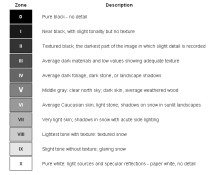Michael, at the end we disagree only by 1/3 of stop... but ZS table specifies middle gray for Z-V, this is the
key reference IMO:
View attachment 265079
Obviously that table became obsolete post 1960 because of the Box speed change in the norms, because the meter started aiming x20 the light in the speed point instead x10, so IMO formally for ZS metering we have to use a full 1 stop correction, not 2/3. Pre-1960 photographers were instructed to meter Z-V at 0+/-, not +1/3 ....
So historically and formally (IMO) the correction is one stop, still using that 2/3 will underexpose (compared to 1959) by 1/3 stop, which is mostly irrelevant in practice.
... So ... let's see ... First, the Zone System speed point is a fixed density above film-base+fog. It has nothing to do with pre- or post-1960 anything. It's its own thing and, as Michael points out, deviates from ISO speed (and earlier ASA speeds) due to the different methods of determining the speed point. It is a convenient simplification of film-speed testing that delivers good negatives. Don't try to correlate the ZS speed point with other, differently determined, speed points.
Second, Zone V falls where it falls after you've determined your speed point, established a working E.I. and found a development time for "N" that puts Zone VIII in the right place. It, by itself, is not a calibration point, and can, in practice, vary from 18% middle grey significantly, even with "N" development. Additionally, Zone System expansions or contractions are going to move Zone V around by a lot; a Zone or more with extremes. Anyone who has made Zone Rulers for their particular film/developer/paper combination knows this just from looking at the stripes on the paper.
Your chart is an idealized description of "N" in the Zone System, not an actual print of anything. Still, as far as a guide to what "N" development should be (according to this 10-Zone model) it is still perfectly valid and relevant, regardless of the change in "box speed" determination around 1960.
If one uses a lower than box speed ISO and the Zone System, one gets a denser negative. Some like that.
Very true. I'm one of those who likes denser negatives (but I'm a boomer... maybe gen Zers like thinner ones?). Still, IM-HO the ideal negative is the one with the least exposure to get the shadow densities and separation one desires.
The problem with box speed for many is that it doesn't deliver the shadow detail expected, for whatever reason. In this case, the simplest solution is to simply rate your film slower than box speed by whatever amount you need to get the shadows you want with your particular meter, metering technique, lens, shutter, film developer, etc., etc. It's a whole lot simpler to do that than to go about calibrating all the other variables. Really, finding a personal E.I. is largely just compensating for the discrepancies and inaccuracies in one's equipment, materials and methods.
If you get shadows that you like at box speed, then fine. FWIW, my preferred E.I.s for the films I use ends up being 1/3 to 2/3 stop slower than box speed, i.e., pretty close to the Zone System speed-point method and not far from box speed.
I do all the ZS film-speed testing à la White, Zakia, Lorenz myself. However, if I were to give someone a down-and-dirty quick-start guide to exposure and development using the Zone System I'd just say, "rate your film 2/3 stop slower than box speed, find a development time that gives you highlights that print well at a medium contrast setting and keep good field notes. Tweak your process as you go based on them."
This, however ignores the main usefulness of the Zone System, which is as a tool for visualizing the final print before exposing the negative. That's a subject for a different thread.
Best,
Doremus





 .
.
